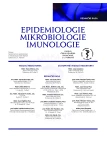Molecular study of mycobacterial strains prevalent in the Czech Republic in 2014
Authors:
M. Pinková; E. Tietzeová; I. Zemanová; V. Dvořáková
Authors‘ workplace:
Státní zdravotní ústav Praha – Národní referenční laboratoř pro mykobakterie
Published in:
Epidemiol. Mikrobiol. Imunol. 68, 2019, č. 3, s. 131-136
Category:
Original Papers
Overview
Aim: To identify Mycobacterium tuberculosis strains prevalent in the Czech Republic in 2014.
Material and methods: DNA from 269 M. tuberculosis strains obtained from patients residing in the Czech Republic in 2014. Based on a step-by-step analysis, the strains were classified into genetically related groups using the MIRU-VNTRplus website.
Results: Four global lineages were identified: 1 Indo-Oceanic, 2 East-Asian (13.8%), 3 Central-Asian, and 4 Euro-American (83.6%) with the following sublineages: Haarlem (44.2%), H37Rv, Cameroon, Latin American-Mediterranean (LAM), Haarlem / X, NEW-1, URAL, S, X, TUR, and UgandaI. Fully identical repetitive sequences were found in 27.1% of strains belonging to two global lineages: 2 East-Asian (2 groups) and 4 Euro-American (21 groups): sublineages Haarlem (11 groups), H37Rv (3 groups), Cameroon (2 groups), Haarlem / X (2 groups), X (1 group), LAM (1 group), and S (1 group). In the set of study strains, seven were multidrug resistant without clustering. Four MDR strains belonging to global lineage 2 East-Asian (Beijing) and three MDR strains belonging to global lineage 4 Euro-American (2 strains of sublineage Latin American-Mediterranean (LAM), and 1 strain of sublineage Haarlem).
Conclusions: A one-year study aimed at the identification of mycobacterial strains prevalent all over the Czech Republic in 2014. The study is the first to present data on the geographical distribution of M. tuberculosis strains in the population.
Keywords:
lineage of Mycobacterium tuberculosis – repetitive sequences – identification
Sources
1. European Centre for Disease Prevention and Control. Tuberculosis surveillance and monitoring in Europe 2016, 17-bře-2016. [Online]. Dostupné na www: http://ecdc.europa.eu/en/publications-data/tuberculosis-surveillance-and-monitoring-europe-2016. [Viděno:15-dub-2019].
2. ÚZIS ČR. Tuberkulóza a respirační nemoci 2013. [Online]. Dostupné na www: https://www.uzis.cz/publikace/tuberkuloza-respiracni-nemoci-2013. [Viděno: 15-dub-2019].
3. Felipe Garcia D., Astudillo M. MIRU-VNTR genotyping of M. tuberculosis in a population of patients from Santiago De Cali, Colombia, 2013-2015, Biomedica, 2019;39.
4. Amlerova J, Bitar I, Hrabak J. Genotyping of Mycobacterium tuberculosis using whole genome sequencing. Folia Microbiol, 2018;63(5):537–545.
5. Supply P, et al. Proposal for Standardization of Optimized Mycobacterial Interspersed Repetitive Unit-Variable-Number Tandem Repeat Typing of Mycobacterium tuberculosis. J Clin Microbiol, 2006, 44(12):4498–4510.
6. Allix-Béguec C, et al. Evaluation and Strategy for Use of MIRU--VNTRplus, a Multifunctional Database for Online Analysis of Genotyping Data and Phylogenetic Identification of Mycobacterium tuberculosis Complex Isolates. J Clin Microbiol, 2008;46(8): 2692–2699.
7. Weniger T, et al. MIRU-VNTRplus: a web tool for polyphasic genotyping of Mycobacterium tuberculosis complex bacteria. Nucleic Acids Res, 2010;38, web server issue:W326–331.
8. WHO. Global tuberculosis report 2018 [online]. Dostupné na www: http://www.who.int/tb/publications/global_report/en/. [Viděno:16-dub-2019].
9. Garzelli C, et al. Impact of immigration on tuberculosis in a low-incidence area of Italy: a molecular epidemiological approach. Clin Microbiol Infect, 2010; 16(11):1691–1697.
10. Gagneux S, Small MP. Global phylogeography of Mycobacterium tuberculosis and implications for tuberculosis product development. Lancet Infect Dis, 2007;7(5):328–337.
11. Nebenzahl-Guimaraes H, et al. Genomic characterization of Mycobacterium tuberculosis lineage 7 and a proposed name: ‘Aethiops vetus’. Microb Genomics, 2016;2(6).
12. Coscolla M, Gagneux S. Consequences of genomic diversity in Mycobacterium tuberculosis. Semin Immunol, 2014;26(6):431–444.
13. Demay C, et al. SITVITWEB – a publicly available international multimarker database for studying Mycobacterium tuberculosis genetic diversity and molecular epidemiology. Infect Genet Evol J Mol Epidemiol Evol Genet Infect Dis, 2012;12(4):755–766.
14. Tietzeová E, Pinková M, Zemanová I. Molekulární epidemiologie tuberkulózy v hlavním městě Praha v letech 2013 a 2014. [Online]. Dostupné na www: https://www.prolekare.cz/casopisy/epidemiologie/2018-2-5/molekularni-epidemiologie-tuberkulozy-v-hlavnim-meste-praha-v-letech-2013-a-2014-104981. [Viděno: 18-dub-2019].
15. Stucki D, et al. Mycobacterium tuberculosis lineage 4 comprises globally distributed and geographically restricted sublineages. Nat Genet, 2016; 48(12):1535–1543.
16. Merker M. et al. Evolutionary history and global spread of the Mycobacterium tuberculosis Beijing lineage. Nat Genet, 2015;47(3):242–249.
17. Valcheva V, et al. Utility of New 24-Locus Variable-Number Tandem-Repeat Typing for Discriminating Mycobacterium tuberculosis Clinical Isolates Collected in Bulgaria. J Clin Microbiol, 2008;46(9):3005–3011.
Labels
Hygiene and epidemiology Medical virology Clinical microbiologyArticle was published in
Epidemiology, Microbiology, Immunology

2019 Issue 3
Most read in this issue
- Incidence and analysis of campylobacteriosis cases in the Czech Republic in 1997–2017
- Prevalence and the role of CCR5Δ32 heterozygosity in disease progression in HIV positive patients in the Czech Republic
- Antiviral adoptive immunotherapy using antigen-specific T cells in allogeneic hematopoietic stem cell transplant recipients
- A high prevalence of viral hepatitis C in a socially excluded Roma community in Brno
